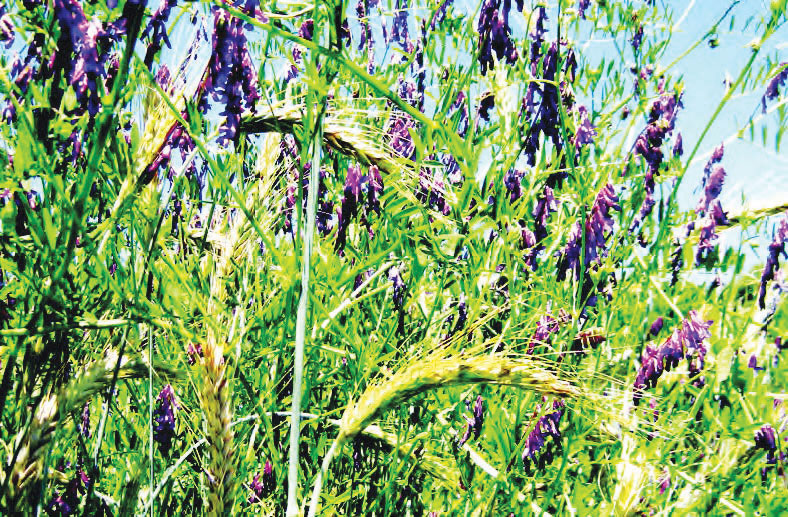Cover Crops: Choosing and Timing
Vetch and grains growing together (image: Ecology Action) It's all about the roots. Did you know that when you plant cover crops, the roots make more compost than the tops? Winter rye makes 380 miles of roots per plant! When the tops are cut, those roots make compost right in the soil, so none of their nitrogen or carbon is lost to the air—and you don't have to haul, turn, or shovel it. Grasses like rye are among the most effective means of sequestering carbon in the soil, and putting it to work building fertile soil organic matter. Legumes like clover pull nitrogen out of the air into nodules on their roots, feeding the plants around and after them. When you plant makes all the difference. With winter cover crops, the size of the root system that develops is largely determined by when you plant. After the soil gets cold, growth slows or stops. To get the best growth, we recommend sowing cover crops 2-4 weeks before your first fall frost.1 Don't be surprised if the plants don't get tall—they will be busy underground. In actual tests, crimson clover that was only 2 inches tall by November nevertheless had roots 12 inches deep, with many nitrogen nodules already fertilizing the soil; rye only 6 inches tall had roots 20 inches deep. With a good head start below ground, those plants will size-up fast in the spring, making lots of biomass for compost material. And most importantly, the roots will be holding your soil, providing channels for water absorption, and adding miles of organic matter to your garden. Seeds don't want to sprout on a warm day in December—they want to make sure winter is really over. So, each seed is programmed to need a specific period (up to 4 months, depending on the variety) in cold, wet, soil before they can sprout when the soil warms. If you plant seeds in the spring that need a period of winter dormancy, they may never sprout, or they may sprout after you have given up and sown another crop on top of them. But how can you plant cover crops in September when so many of your garden beds are still producing vegetables? Here are some options:
What to Plant? Let Nature be your guide. Most meadows and prairies have a biodiverse mixture of grasses, legumes, and tap-rooted plants that can grow thickly by filling different niches in their over- and under-stories, hold the soil from erosion, prevent compaction, absorb water, and build the soil. The famously fertile topsoil of the midwestern United States were built by just such assemblages of plants. You can mimic that soil-building synergy in your garden by making a mix that includes each of the types below:
In a smaller bed, or a front yard, where you
don't want tall grasses, choose lower-growing
options:
A great new idea—the nutrient-trap buffer strip: If your garden has any slope to it—even a gentle slope—it is almost impossible to avoid losing soil and dissolved nutrients downhill over the course of the winter and early spring. Organic matter is lighter than the sand or clay fractions of soil, and floats away easily. We have seen large amounts of humus recovered from swales at the lowest point of the garden. A great way to keep fertility from leaving your garden it is to plant fast-growing and nutrient-trapping cover crops in a strip at the bottom end of your garden. Rye in winter and alfalfa in summer, or bee's friend in winter and buckwheat in summer—there are many possibilities. The key is to absorb all runoff and turn it into plant matter for composting. We know market gardeners who have made this a major source of fertility for their spring startup. Don't forget pots and containers. A low-growing, blooming cover crop prevents your pots, (with their expensive soil mix), from being taken over by weeds. Calendula, poppies, Bee's Friend, salad greens, and peas are great for this. Or consider a “second harvest” mix of Calendula, Bronze Arrow lettuce, Giant Winter Spinach, mizuna, daikon radish, and Austrian Winter Field Pea for a winter pot garden. For more on individual crops and situations, see our Compost/Cover Crop Chart . _____________ 1 For practical purposes, your frost date is when you can expect a forecast of 36 degrees or lower. Why? Weather station equipment is installed at standing height or even at roof level. The temperature below, on the ground, can be colder than the instruments show. So when the forecast expects 36 degrees at the weather station, you can expect 32 degrees at the soil surface. In low spots and areas where air drainage is blocked, it can be even colder. You can find first and last frost dates online by searching for "first and last frost date" and your zip code ♥ top | Newsletter Home |Table of Contents| Archive
|



